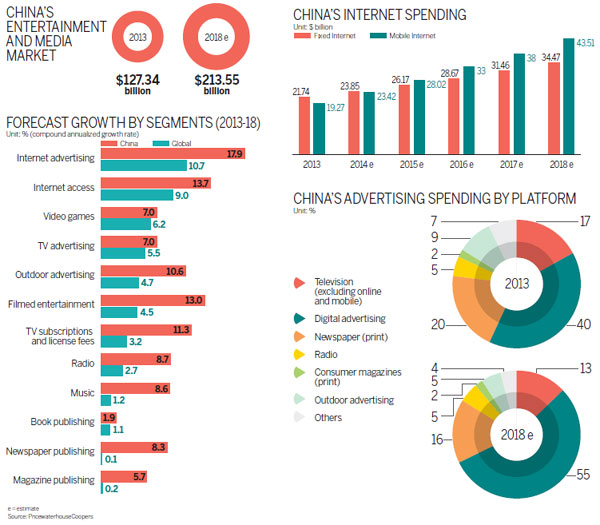New star emerging in global media market
 0 Comment(s)
0 Comment(s) Print
Print E-mail China Daily, June 4, 2014
E-mail China Daily, June 4, 2014

China will overtake Japan to become the world's second-largest entertainment and media market by the end of 2018, next only to the United States, according to the Global Entertainment and Media Outlook 2014-18, published by global consultancy PricewaterhouseCoopers on Tuesday.
Overall spending in the E&M segments in China is forecast to grow at 10.9 percent compound annual growth rate through to 2018, including an 11.8 percent CAGR in overall advertising spending. On the other hand, the global E&M industry is foreseen to grow by an overall 5 percent CAGR through 2018.
"The coming of age of China as the world's second-largest entertainment and media market in 2018 is a reflection of the consumption power of a growing middle class that is both the target of increasing brand activity as well as a potent force itself in the demand for all forms of entertainment," said Marcel Fenez, PwC's global leader in entertainment and media division.
Advertising, especially in the digital sector, is leading the way in the growth of China's E&M industry. PwC said that 55 percent of total advertising revenue is forecast to be digital in 2018, while total E&M spending on digital, excluding spending on Internet access, is forecast to grow at a 15.5 percent CAGR between 2013 and 2018, and account for 53 percent of China's entertainment and media spending growth.
Spending on digitally delivered content will account for only 22 percent of total consumer spending in 2018, excluding spending on Internet access, compared with 55 percent of total advertising spending. However, the growth of 24/7 access and micro-transactions suggest that the key to monetizing the digital consumer is to adopt flexible business models that offer more choices, the PwC report said.
Fenez also suggested that monetizing the growing demand from the digital consumer remains a challenge.
"It requires media organizations to adopt strategies that have a digital mind-set at the core and involve the development of three critical behaviors—forging trust with consumers, creating the confidence to move with speed and agility, and empowering innovation," he said.
In this sense, not every organization that has adopted a digital strategy turns out to be a success. Zhuo Wenjie, senior director at Yum Brands Inc, said that quite a few brands have failed to find satisfactory solutions in digital media. As a result, Zhuo predicted that some would return to traditional media.
"Different versions of advertisements have to be prepared for digital media according to the varying demands from different consumers, which adds more cost," she said.
In contrast to the rapid growth of digital media, TV and newspaper advertising grew annually at 7 percent and 7.5 percent, respectively, and will lose share to the Internet, the PwC survey reported.
But that does not mean doomsday for traditional media.
"While the effectiveness of TV commercials has been declining, that of good content and well-established brands has been enhanced. Today, TV is still the most effective medium to build brands," said Tan Beiping, director of Beijing-based media think tank Panmedia Institute.
"To integrate traditional and digital media means integrating content, operation modes and marketing."






Go to Forum >>0 Comment(s)